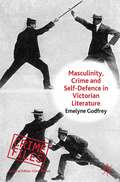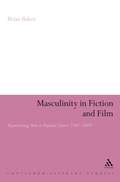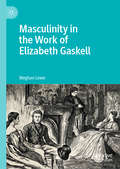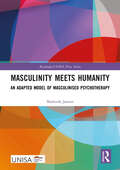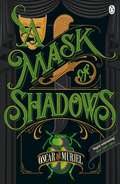- Table View
- List View
Masculinity and Spirituality in Victorian Culture
by Andrew Bradstock Sue MorganIn its specially-commissioned fourteen chapters, this important book discusses an impressively wide range of issues around the theme of male spirituality in the nineteenth century, drawing from history, cultural studies, art history and literary criticism. Topics explored include: ideological and iconographical representations of masculinity across the major Christian denominations; militarism and hymnody; male homosexuality and homoeroticism. The book is not afraid to explore controversial areas, nor to go beyond the generally acknowledged 'canon' of prescribers of gender identity: it includes, for example, leading nonconformist figures like William Booth and Charles Haddon Spurgeon, and early gay writers like John Addington Symonds.
Masculinity and the Metropolis of Vice, 1550–1650 (Early Modern Cultural Studies 1500–1700)
by A. Bailey R. HentschellLeading authors in the field of early modern studies explore a range of bad behaviours - like binge drinking, dicing, and procuring prostitutes at barbershops - in order to challenge the notion that early modern London was a corrupt city that ruined innocent young men.
Masculinity and the Trials of Modern Fiction
by Marco WanHow do lawyers, judges and jurors read novels? And what is at stake when literature and law confront each other in the courtroom? Nineteenth-century England and France are remembered for their active legal prosecution of literature, and this book examines the ways in which five novels were interpreted in the courtroom: Gustave Flaubert’s Madame Bovary, Paul Bonnetain’s Charlot s’amuse, Henry Vizetelly’s English translation of Émile Zola’s La Terre, Oscar Wilde’s The Picture of Dorian Gray and Radclyffe Hall’s The Well of Loneliness. It argues that each of these novels attracted legal censure because they presented figures of sexual dissidence – the androgyne, the onanist or masturbator, the patricide, the homosexual and the lesbian – that called into question an increasingly fragile normative, middleclass masculinity. Offering close readings of the novels themselves, and of legal material from the proceedings, such as the trial transcripts and judicial opinions, the book addresses both the doctrinal dimensions of Victorian obscenity and censorship, as well as the reading practices at work in the courtroom. It situates the cases in their historical context, and highlights how each trial constitutes a scene of reading – an encounter between literature and the law – through which different forms of masculinity were shaped, bolstered or challenged.
Masculinity and the Trials of Modern Fiction
by Marco WanHow do lawyers, judges and jurors read novels? And what is at stake when literature and law confront each other in the courtroom? Nineteenth-century England and France are remembered for their active legal prosecution of literature, and this book examines the ways in which five novels were interpreted in the courtroom: Gustave Flaubert’s Madame Bovary, Paul Bonnetain’s Charlot s’amuse, Henry Vizetelly’s English translation of Émile Zola’s La Terre, Oscar Wilde’s The Picture of Dorian Gray and Radclyffe Hall’s The Well of Loneliness. It argues that each of these novels attracted legal censure because they presented figures of sexual dissidence – the androgyne, the onanist or masturbator, the patricide, the homosexual and the lesbian – that called into question an increasingly fragile normative, middleclass masculinity. Offering close readings of the novels themselves, and of legal material from the proceedings, such as the trial transcripts and judicial opinions, the book addresses both the doctrinal dimensions of Victorian obscenity and censorship, as well as the reading practices at work in the courtroom. It situates the cases in their historical context, and highlights how each trial constitutes a scene of reading – an encounter between literature and the law – through which different forms of masculinity were shaped, bolstered or challenged.
Masculinity, Autocracy and the Russian University, 1804-1863
by R. FriedmanThis is the first book-length study of masculinity in Imperial Russia. By looking at official and unofficial life at universities across the Russian empire, this project offers a picture of the complex processes through which gender ideologies were forged and negotiated in the Nineteenth Century. Masculinity, Autocracy and the Russian University, 1804-1863 demonstrates how gender was critical to political life in a European monarchy.
Masculinity, Class and Same-Sex Desire in Industrial England, 1895-1957 (Genders and Sexualities in History)
by Helen SmithMasculinity, Class and Same-Sex Desire in Industrial England, 1895-1957 explores the experiences of men who desired other men outside of the capital. In doing so, it offers a unique intervention into the history of sexuality but it also offers new ways to understand masculinity, working-class culture, regionality and work in the period.
Masculinity, Crime and Self-Defence in Victorian Literature: Duelling with Danger (Crime Files)
by E. GodfreyNow in paperback, this book considers crime fighting from the perspective of the civilian city-goer, from the mid-Victorian garotting panics to 1914. It charts the shift from the use of body armour to the adoption of exotic martial arts through the works of popular playwrights and novelists, examining changing ideals of urban, middle-class heroism.
Masculinity in Contemporary Science Fiction Cinema: Cyborgs, Troopers and Other Men of the Future (Library of Gender and Popular Culture)
by Marianne Kac-VergneIf science fiction stages the battle between humans and non-humans, whether alien or machine, who is elected to fight for us? In the classics of science fiction cinema, humanity is nearly always represented by a male, and until recently, a white male. Spanning landmark American films from Blade Runner to Avatar, this major new study offers the first ever analysis of masculinity in science fiction cinema. It uncovers the evolution of masculine heroes from the 1980s until the present day, and the roles played by their feminine counterparts. Considering gender alongside racial and class politics, Masculinity in Contemporary Science Fiction Cinema also brilliantly situates filmic examples within the broader culture.In view of its largely young male audience, what masculine norms and models of behaviour are promoted by science fiction films? During the 1980s, the genre helped to redefine white masculinity in America as both powerful and victimised. Heroes embodied Reagan-era hypermasculinity, but owed their resolve to earlier traumas inflicted by greedy and technology-obsessed elites, a critique of the decade's materialism. By the 1990s, the emotional terrain available to male characters was expanded, even witnessing the humanisation of the Terminator, and black characters entered the stage. At the same time, the world of science fiction became increasingly sanitised, moving away from the dystopias of the 1980s. Can science fiction call into question the privileged position of whiteness as the invisible and universal norm for the whole of humanity? In many ways, science fiction challenges the status quo, offering an imaginary space where identities are renegotiated. Working-class heroes fight corrupt corporations (Escape from New York or RoboCop), powerful heroines battle for survival (Alien), and cyborgs morph from one sex to another (Terminator 2). Considering these alternative visions, the book highlights the tensions inherent to science fiction as a genre. It is indispensable for understanding science fiction and its role in contemporary cultural politics.
Masculinity in Fiction and Film: Representing men in popular genres, 1945-2000 (Continuum Literary Studies)
by Brian BakerThis book looks at a wide range of fiction and film texts, from the 1950s to the present, in order to analyse the ways in which masculinity has been represented in popular culture in Britain and the United States. It covers numerous genres, including spy fiction, science fiction, the Western and police thrillers. Each chapter focuses on key forms of masculinity found in each genre, such as the 'double agent', the 'rogue cop' and the 'citizen-soldier'.Brian Baker takes a broad, contextual approach, placing a detailed discussion of key texts and issues concerning masculinity in their historical and cultural context. Written in a clear, accessible way, it explores the changing representation of men over the last fifty years.
Masculinity in Lesbian “Pulp” Fiction: Disappearing Heteronormativity? (Routledge Research in Gender and Society)
by Paul ThompsonThis book looks specifically and in depth, for the first time, at masculinity in cheap, lesbian-themed paperbacks of the two decades after WW2. It challenges established critical assumptions about the readership, and sets the masculinity imagined in these novels against the “masculinity crisis” of the era in which they were written.The key issue of these novels is couplehood as much as sexuality, and the instability of masculinity leads to the instability of the couple. Thompson coins the term “heteroemulative” to describe the struggle that both heterosexual and homosexual couples have in conforming to heteronormativity.As several of these novels have been republished and remain in print, they have taken on a new relevance to issues of sexuality and gender in the twentyfirst century, and this study will attract readers within that area of interest. A valuable read for sociologists studying gender roles, and social historians of the cold war period in the United States. It is suitable for readers of all academic levels, from undergraduate, through postgraduate, to scholars and researchers, but also for a general readership.
Masculinity in Lesbian “Pulp” Fiction: Disappearing Heteronormativity? (Routledge Research in Gender and Society)
by Paul ThompsonThis book looks specifically and in depth, for the first time, at masculinity in cheap, lesbian-themed paperbacks of the two decades after WW2. It challenges established critical assumptions about the readership, and sets the masculinity imagined in these novels against the “masculinity crisis” of the era in which they were written.The key issue of these novels is couplehood as much as sexuality, and the instability of masculinity leads to the instability of the couple. Thompson coins the term “heteroemulative” to describe the struggle that both heterosexual and homosexual couples have in conforming to heteronormativity.As several of these novels have been republished and remain in print, they have taken on a new relevance to issues of sexuality and gender in the twentyfirst century, and this study will attract readers within that area of interest. A valuable read for sociologists studying gender roles, and social historians of the cold war period in the United States. It is suitable for readers of all academic levels, from undergraduate, through postgraduate, to scholars and researchers, but also for a general readership.
Masculinity in Medieval Europe (Women And Men In History)
by Dawn HadleyAn original and highly accessible collection of essays which is based on a huge range of historical sources to reveal the realities of mens' lives in the Middle Ages. It covers an impressive geographical range - including essays on Italy, France, Germany and Byzantium - and will span the entire medieval period, from the fourth to the fifteenth century. The collection is divided into four main sections: attaining masculinity; lay men and churchmen: sources of tension; sexuality and the construction of masculinity; and written relationships and social reality.The contributors are:Dawn Hadley, Jenny Moore, William M. Aird, Jeremy Goldberg, Matthew Bennet, Janet Nelson, Conrad Leyser, Robert Swanson, Patricia Cullum, Ross Balzaretti, Shaun Tougher, Julian Haseldine, Marianne Ailes and Mark Chinca.
Masculinity in Medieval Europe (Women And Men In History)
by Dawn HadleyAn original and highly accessible collection of essays which is based on a huge range of historical sources to reveal the realities of mens' lives in the Middle Ages. It covers an impressive geographical range - including essays on Italy, France, Germany and Byzantium - and will span the entire medieval period, from the fourth to the fifteenth century. The collection is divided into four main sections: attaining masculinity; lay men and churchmen: sources of tension; sexuality and the construction of masculinity; and written relationships and social reality.The contributors are:Dawn Hadley, Jenny Moore, William M. Aird, Jeremy Goldberg, Matthew Bennet, Janet Nelson, Conrad Leyser, Robert Swanson, Patricia Cullum, Ross Balzaretti, Shaun Tougher, Julian Haseldine, Marianne Ailes and Mark Chinca.
Masculinity in the Work of Elizabeth Gaskell
by Meghan LoweThis book is the first full-length study to focus on the representation of masculinity in Elizabeth Gaskell’s novels. In examining Gaskell’s understanding of masculine identity as a social construct and considering how her writing engages with Victorian ideologies of gender, this book demonstrates that Gaskell defies an essentialist approach to gender and instead explores masculinity over time, genre, region, and class, making it clear that masculinity is not monolithic but relational, culturally constructed, and dependent on many contexts. It analyses Gaskell’s depiction of what it means to be a ‘man’ and a ‘gentleman’, exploring Mary Barton, North and South, Ruth, Cousin Phillis, Sylvia’s Lovers, and Wives and Daughters, as well as contemporary Victorian works and key contexts such as sympathy, historic change, and industrialism. The target audiences are academics, as well as undergraduate and postgraduate students and research specialists, and it will most appeal to Victorian Literature, Gender Studies, and Masculinity Studies disciplines.
Masculinity Meets Humanity: An Adapted Model of Masculinised Psychotherapy (Routledge/UNISA Press Series)
by Shahieda JansenIn this book the author, a clinical psychologist, reflects on her psychotherapy experiences with male clients as she debunks the myth of male alexithymia, the inability to recognise and express emotions. Men are apparently disengaged from wellness practices as they are perceived to be reluctant to seek mental health care. An ubuntu-inspired personhood discourse of trust, empathy and transformation theoretically underpins the author’s clinical practice. The integration of the culturally familiar philosophy of ubuntu challenges the hegemony of strictly modern Western psychological discourses and theories. Although the book is not a manual for how to do therapy with men, neither a panacea for all male related challenges, it can ignite empathic insights and kindle gender sensitive responses to male concerns, locally and internationally. Women, who are frequently the targets of gender-based violence primarily committed by men, may play a significant role in the rehabilitation and healing of men. Men are usually excluded from psychosocial interventions, but this book makes the case that prioritsing the wellbeing of boys and men is critical to creating a society that is safe for everyone—men, women, children, and the broader public. Print editions not for sale in Sub-Saharan Africa.
Masculinity Meets Humanity: An Adapted Model of Masculinised Psychotherapy (Routledge/UNISA Press Series)
by Shahieda JansenIn this book the author, a clinical psychologist, reflects on her psychotherapy experiences with male clients as she debunks the myth of male alexithymia, the inability to recognise and express emotions. Men are apparently disengaged from wellness practices as they are perceived to be reluctant to seek mental health care. An ubuntu-inspired personhood discourse of trust, empathy and transformation theoretically underpins the author’s clinical practice. The integration of the culturally familiar philosophy of ubuntu challenges the hegemony of strictly modern Western psychological discourses and theories. Although the book is not a manual for how to do therapy with men, neither a panacea for all male related challenges, it can ignite empathic insights and kindle gender sensitive responses to male concerns, locally and internationally. Women, who are frequently the targets of gender-based violence primarily committed by men, may play a significant role in the rehabilitation and healing of men. Men are usually excluded from psychosocial interventions, but this book makes the case that prioritsing the wellbeing of boys and men is critical to creating a society that is safe for everyone—men, women, children, and the broader public. Print editions not for sale in Sub-Saharan Africa.
The Mask and the Flag: Populism, Citizenism and Global Protest (PDF)
by Paolo GerbaudoFrom the Arab Spring to the Spanish Indignados, from Occupy Wall Street in New York to Nuit Debout in Paris, contemporary protest bears the mark of citizenism, a libertarian and participatory brand of populism which appeals to ordinary citizens outraged at the arrogance of political and financial elites in the wake of the Great Recession. This book draws on 140 interviews with activists and participants in occupations and demonstrations to explore the new politics nurtured by the ‘movement of the squares’ of 2011–16 and its reflection of an exceptional phase of crisis and social transformation. Gerbaudo demonstrates how, in waging a unifying struggle against a perceived Oligarchy, today’s movements combine the neo-anarchist ethos of horizontality and leaderlessness inherited from the anti-globalisation movement, and a resurgent populist demand for full popular sovereignty and the reclamation of citizenship rights. He analyses the manifestation of this ideology through the signature tactics of these upheavals, including protest camps in public squares, popular assemblies and social media activism. And he charts its political ramifications from Podemos in Spain to Bernie Sanders in the US, revealing how the central square occupations have been foundational to current movements for radical democracy worldwide.
The Mask of Command: A Study of Generalship
by John KeeganThe Mask of Command is about generals: who they are, what they do and how they affect the world we live in. Through portraits of four generals - archetypal hero Alexander the Great, anti-hero Wellington, the unheroic Ulysses S. Grant and the false heroic of Hitler - John Keegan propounds the view of heroism in warfare as inextricable linked with the political imperative of the age and place. He demonstrates how the role of the general alters with the ethos of the society that creates him and concludes that there is no place for heroism in a nuclear world. The Mask of Command is a companion volume to John Keegan's classic study of the individual soldier, The Face of Battle: together they form a masterpiece of military and human history.
The Mask of Command (Twilight of Empire #4)
by Ian RossRoss presents us with a vision of late Rome that is tense, exhilarating, complex and exotic... When a treacherous act of murder throws the western provinces into turmoil, Aurelius Castus is ordered to take command of the military forces on the Rhine. But he soon discovers that the frontier is a place where the boundaries between civilisation and barbarism, freedom and slavery, honour and treason have little meaning. At the very heart of the conflict are two vulnerable boys. One is Emperor Constantine's young heir, Crispus. The other is Castus's own beloved son, Sabinus. Only Castus stands between them and men who would kill them. With all that he loves in danger, Castus and a handful of loyal men must fight to defend the Roman Empire. But in the heat of battle, can he distinguish friend from enemy?
The Mask of Ra: A novel of intrigue and murder set in Ancient Egypt (The\amerotke Ser. #Vol. 1)
by Paul DohertyThe Pharaoh is murdered... who can the city of Thebes trust to uncover the truth?The Mask of Ra, the first mystery in Paul Doherty's intriguing series set in Ancient Egypt, introduces readers to his enigmatic sleuth, Amerotke, for the first time. Perfect for fans of Brad Geagley and Wilbur Smith. 'The historical mystery genre is still thriving and Paul Doherty's The Mask of Ra is the best of its kind since the death of Ellis Peters. As ever, Doherty dazzles with his knowledge and intimate feel for ancient Egypt' - Time Out His great battles against the sea raiders in the Nile Delta have left Pharaoh Tuthmosis II frail, but he finds solace in victory and in the welcome he is sure to receive on his return to Thebes. Across the river from Thebes, however, there are those who do not relish his homecoming, and a group of assassins has taken a witch to pollute the Pharaoh's unfinished tomb. Reunited with his wife, Hatusu, and his people, Tuthmosis stands before the statue of Amun-Ra with the roar of the crowd and the fanfare of trumpets ringing in his ears. But within an hour he is dead and the people of Thebes cannot forget the omen of wounded doves flying overhead. Rumours run rife, speculation sweeps the royal city and Hatusu vows to uncover the truth. With the aid of Amerotke, a respected judge of Thebes, she embarks on a path destined to reveal the great secrets of Egypt.What readers are saying about The Mask of Ra:'This is the best book I have ever read''A classic whodunit, it nevertheless manages to spring a few surprises on the way, and I certainly didn't manage to guess who the culprit was''Mr. Doherty takes time to establish the site and atmospheric setting of his story...I barged through the book in one night'
A Mask of Shadows: Frey & McGray Book 3 (A Victorian Mystery #3)
by Oscar De Muriel'A hugely entertaining Victorian mystery' New York Times'I enjoyed this - properly creepy and Gothic' Ian Rankin1889. The Scottish Play is coming home.But before the darling couple of London theatre, Henry Irving & Ellen Terry, take their acclaimed Macbeth to the Edinburgh stage terror treads the boards. A grisly message found smeared across the cobbles in blood, foretelling someone's demise. As the bloody prophecies continue to appear Edinburgh's own beloved pair - Detective 'Nine-Nails' McGray & Inspector Ian Frey - enter the scene. Frey scoffs at this blatant publicity stunt, while McGray is convinced of supernatural affairs. As they scrutinise the key players, they discover that Terry, Irving, and his peculiar, preoccupied assistant (one Bram Stoker) all have reasons to kill, or be killed...But one thing is clear. By occult curse or human hand, death will take bow the night the curtain rises.Praise for the Frey & McGray series:'I enjoyed this - properly creepy and Gothic' Ian Rankin'A hugely entertaining Victorian mystery' New York Times'This is wonderful. A brilliant, moving, clever, lyrical book - I loved it. Oscar de Muriel is going to be a name to watch' Manda Scott'Fun to read and a fast page-turner. Love and murder - they go together like strawberries and cream' Independent'A brilliant mix of horror, history, and humour. Genuinely riveting with plenty of twists, this will keep you turning the pages. It's clever, occasionally frightening and superbly written ... Everything you need in a mystery thriller' Crime Review'Fast-paced, well-researched and thoroughly spellbinding. The mismatched pair is as entertaining as Holmes and Watson at their best' Historical Novel Society
The Mask of Tutankhamun (Large Print)
This image shows the gold mask of King Tutankhamun. A locator dot and title are shown. These must always be at the top left of the page when the image is the right way up. The king's face, in the centre of the image, is surrounded by a highly decorated headdress and neck piece. At the top of the image, the headdress has emblems of a cobra and an eagle. The cobra on the right is facing forward, with both eyes, its narrow mouth and patterned neck showing. To the left of this is the eagle, which also faces forward with both eyes and its beak showing above its neck. Just below these creatures is Tutankhamun's face which is heavily made up, so that his eyebrows, eyes, nose, mouth and ears can easily be found. Around his face is the decorative headdress, and an ornamental piece is attached to his chin. At the bottom of the image, the highly decorative neck piece curves upwards at each side to join the headdress.
The Mask of Tutankhamun (UEB Contracted)
This image shows the gold mask of King Tutankhamun. A locator dot and title are shown. These must always be at the top left of the page when the image is the right way up. The king's face, in the centre of the image, is surrounded by a highly decorated headdress and neck piece. At the top of the image, the headdress has emblems of a cobra and an eagle. The cobra on the right is facing forward, with both eyes, its narrow mouth and patterned neck showing. To the left of this is the eagle, which also faces forward with both eyes and its beak showing above its neck. Just below these creatures is Tutankhamun's face which is heavily made up, so that his eyebrows, eyes, nose, mouth and ears can easily be found. Around his face is the decorative headdress, and an ornamental piece is attached to his chin. At the bottom of the image, the highly decorative neck piece curves upwards at each side to join the headdress.
The Mask of Tutankhamun (UEB Uncontracted)
This image shows the gold mask of King Tutankhamun. A locator dot and title are shown. These must always be at the top left of the page when the image is the right way up. The king's face, in the centre of the image, is surrounded by a highly decorated headdress and neck piece. At the top of the image, the headdress has emblems of a cobra and an eagle. The cobra on the right is facing forward, with both eyes, its narrow mouth and patterned neck showing. To the left of this is the eagle, which also faces forward with both eyes and its beak showing above its neck. Just below these creatures is Tutankhamun's face which is heavily made up, so that his eyebrows, eyes, nose, mouth and ears can easily be found. Around his face is the decorative headdress, and an ornamental piece is attached to his chin. At the bottom of the image, the highly decorative neck piece curves upwards at each side to join the headdress.
Masked by Moonlight: The Redemption Of Jake Scully Masked By Moonlight (Mills And Boon Historical Ser.)
by Allie PleiterIndulge your fantasies of delicious Regency Rakes, fierce Viking warriors and rugged Highlanders. Be swept away into a world of intense passion, lavish settings and romance that burns brightly through the centuries The man behind the mask.





